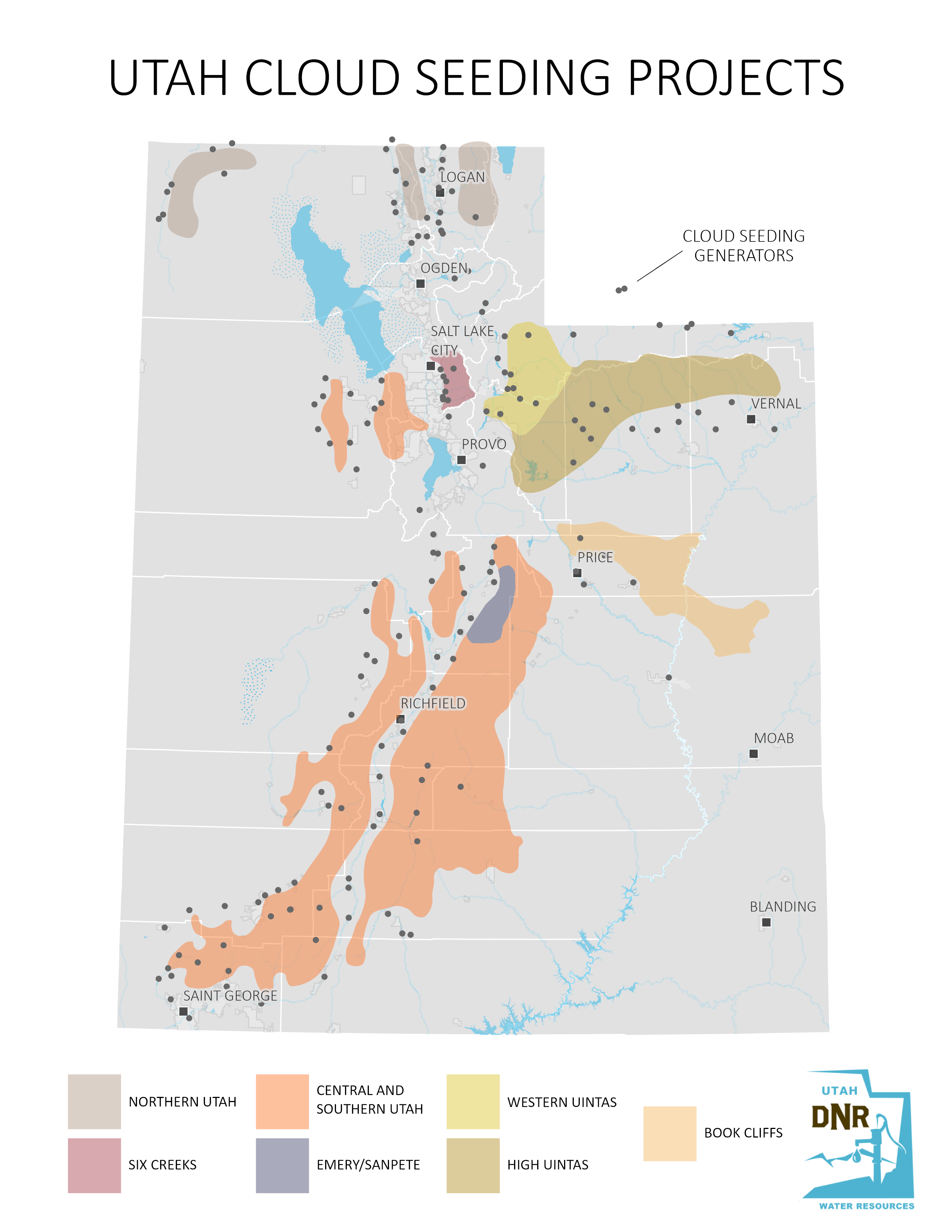
Enhancing our water supply
Utah has been cloud seeding since the early 1950s to help augment the state’s water supply. The Cloud Seeding Act of 1973 gave authority to the Utah Division of Water Resources to oversee state cloud seeding projects. Ground-based seeders shoot silver iodide into winter clouds where it helps form ice crystals. The seeders are placed along foothills and higher elevations where the release of the cloud seeds is timed so that air currents carry them high into the cloud.
This process is effective because clouds are formed by water vapor and dust. Under certain natural conditions those water droplets will freeze together around the dust or other particles and, when heavy enough, will fall from the sky as snow. Often, there is more snow that can fall but limited by the number of particles around which ice crystals can form. That is why adding particles, or seeds, facilitates and accelerates the process which may lead to more snow falling than would have under natural conditions.
Why is the state of Utah involved in cloud seeding?
Since snowpack is Utah’s largest reservoir, increasing the amount of snow that falls is a win for the water supply. It doesn’t work just anywhere. The conditions have to be right. Luckily, Utah’s topography, climate and reservoirs make winter snowpack enhancement cost-effective. Statistical analysis shows an average increase in precipitation of 5-15% in seeded areas at a cost between $10 -$15 per acre-foot for the additional water. The field program runs November to April and is funded jointly by the state and local water interests.
Cloud seeding can only occur when there is sufficient water in the atmosphere, which is why Utah’s cloud seeding takes place only in the winter. There is insufficient local support for a summer seeding program and Utah’s semi-arid climate doesn’t present the right conditions to generate enough precipitation. (Summer months are often too dry and don’t have enough clouds.) In 2023, the Utah Legislature allocated $12 million in one-time funding and provided an annual budget of $5 million to the division. Costs for cloud seeding programs are split with local sponsors.
Questions?
Contact: Jonathan Jennings at jjennings@utah.gov
Additional Resources
- Cloud Seeding FAQ (February 2024)
- 2023 Cloud Seeding Symposium Report (September 2023)
- Vox: Humans finally figured out how to make it rain (cloud seeding in Texas, 2022)
- Update on a Long-term Winter Operational Cloud Seeding Program in Central/Southern Utah (April 2022)
- CNET: Weather modification tech: How cloud seeding increases rainfall (cloud seeding in California, 2021)
- Cloud Seeding Presentation for the Board of Water Resources (October 2020)
- Towards the Improvement of Winter Orographic Cloud (December 2019)
- Utah’s Cloud Seeding Suspension Criteria (May 2019)
- Utah Cloud Seeding: Increased Runoff and Cost Analyses (January 2018)
- Geochemistry and Impacts of Silver Iodide Use in Cloud Seeding (May 2011)
- Weather Modification Association Environmental Impact Position Statement (July 2009)
- Cloud Seeding: The Utah Experience (April 2001)
- Uinta Mountains and Basin: Assessment of Extra Area Cloud Seeding (November 1990)
- Uinta Basin-Wasatch Front: Precipitation Pattern Analysis (October 1990)
- USU Climate Center – Support and publicly available model results that are used by operators in real-time.
Cloud Seeding Reports
2022-2023
- Book Cliffs 2022-2023
- High Uintas 2022-2023
- Northern Utah 2022-2023
- Six Creeks 2022-2023
- Southern and Central Utah 2022-2023
- Western Uintas 2022-2023
2021-2022

